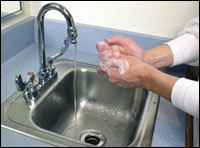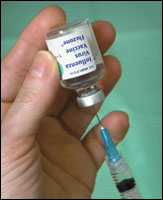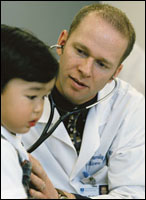Seasonal Flu
Employer Guidance
Reducing Healthcare Workers' Exposures to Seasonal Flu Virus
This guidance provides baseline infection control procedures for seasonal flu. As new information about the current seasonal flu virus becomes available, this workplace guidance will be reevaluated and updated. Employers should ensure that they have the most up-to-date information when making decisions about their current operations and planning.
Workers who perform certain types of healthcare tasks for patients who may have the flu are at a higher risk of exposure to the seasonal flu virus and need additional precautions to protect them from workplace infection. This page gives employers and managers information about how to protect workers who perform tasks that require close contact with patients who may have the flu. It also lists precautions for tasks involving close contact with specimens or contaminated materials from flu patients. Workers who are at risk include those who perform direct patient care, aerosol-generating procedures, specimen analysis, and other patient support, like dietary and housekeeping services. These tasks can be performed in different settings such as inpatient and outpatient healthcare facilities; home healthcare settings; and health services facilities in schools, industrial workplaces, or correctional institutions.
Healthcare employers need to use a combination of controls to protect workers and help reduce the transmission of the seasonal flu virus, including:
- promoting, administering and making readily accessible the annual flu vaccine to all workers
- encouraging sick workers to stay at home
- emphasizing hand hygiene and cough etiquette
- using airborne infection isolation rooms
- ensuring proper functioning of the heating, ventilation, and air conditioning (HVAC) system in patient rooms, procedure rooms, and examination rooms
- limiting the transport of infectious patients throughout the healthcare facility
- limiting the number of healthcare staff who come in contact with flu patients
- giving proper personal protective equipment (PPE) (gloves, gowns, surgical masks, respirators) to healthcare staff and ensuring that it is used and discarded correctly.
For seasonal flu, CDC recommends that workers wear a fit tested N95 disposable respirator while performing high-risk, aerosol-generating procedures on flu patients. Employers who require workers to wear respirators (N95 disposable respirators or better) must have a complete respiratory protection program in place that meets the requirements in the OSHA standard, 29 CFR 1910.134. Additional information about respirator use is included below and in CDC’s Prevention Strategies for Seasonal Influenza in Healthcare Settings. Employers are responsible for making sure that workers are trained to use and discard PPE correctly, including respirators.
Pandemic flu remains a concern for all employers, especially healthcare employers. A pandemic can occur at any time and can be mild, moderate, or severe. The pandemic in 2009 was considered by CDC to be mild but it still created challenges for employers and showed that many workplaces were not prepared. The precautions identified in this guidance give a baseline for infection control during a seasonal flu outbreak, but they may not be enough to protect workers during a pandemic. Your pandemic flu plan should be based on a "worst-case" scenario – one in which the virus causes severe illness and death in larger numbers of people. Planning for the worst-case ensures that you will have the right type of equipment and an adequate supply of it on hand to protect workers. It also ensures that you have planned for additional control options so that you can pick the right combination for the specific pandemic flu virus. For additional information on pandemic flu planning, see OSHA’s Pandemic Influenza Preparedness and Response Guidance for Healthcare Workers and Healthcare Employers and CDC’s healthcare planning resources.
Basic Precautions for All Work Activities
Encourage Workers to Get Vaccinated
The CDC strongly recommends that you provide the seasonal flu vaccine to healthcare workers and encourage them to get vaccinated. Vaccination is the most important way to prevent the spread of the flu. Healthcare and emergency medical services personnel are a priority group for receiving the flu vaccine. See CDC’s Influenza Vaccination Information for Healthcare Workers for information on healthcare workers and the flu vaccine.
Encourage Sick Workers to Stay Home
Encourage sick workers to stay home. The CDC recommends that workers who have a fever and respiratory symptoms stay at home until 24 hours after their fever ends (100 degrees Fahrenheit [37.8 degrees Celsius] or lower), without the use of medication. Not everyone who has the flu will have a fever. Other symptoms could include a runny nose, body aches, headache, tiredness, diarrhea, or vomiting.
Develop flexible leave policies that encourage workers to stay home, without penalty, if they are sick. Discuss other human resource policies with staff, including administrative leave transfer between employees, pay policy for sick leave, childcare options, and what to do when ill during travel.
Monitor Flu Activity
Communicate with state and local health departments and monitor flu activity in your community. CDC recommends that you assign one person the job of communicating with the state and local health departments about flu activity in your community and giving this information to workers in your facility. You may decide to use additional precautions (see below) when flu activity is higher in your community, and it is important that workers know when to begin using them.
Develop a Policy for Ill Workers and Consider Additional Medical Surveillance and Screening
Useful CDC resources: Health Habits to Help Protect Against Flu, and Hand Hygiene in Healthcare Settings.
Develop a policy on how to deal with workers who may be ill with the flu and communicate it to your workers. Use CDC's Prevention Strategies for Seasonal Influenza in Healthcare Settings to develop this type of policy for healthcare settings.
Workers who have a fever and respiratory symptoms should not report to work until 24 hours after their fever ends (100 degrees Fahrenheit [37.8 degrees Celsius] or lower), without the use of medication.
- CDC has special instructions for workers returning to work in areas with patients whose immune systems are severely weakened.
- During periods when flu activity increases in your community, consider screening workers for flu symptoms before their shift starts and tracking absences of workers who care for flu patients. Make sure that workers with symptoms and who become ill have access to medical advice and early treatment.
Encourage workers to report their own flu-like symptoms and leave early, if needed.
Promote Hand Hygiene and Cough Etiquette

Workers, patients, and visitors should be trained how to use proper hand hygiene and cough etiquette. Infection control officers should enforce both.
Workers, patients, and visitors should have easy access to supplies such as:
- "No touch" wastebaskets for used tissues;
- Soap and water;
- Alcohol-based hand rubs;
- Disposable towels; and
- Cleaning and sanitation materials.
Lobbies, halls, and restrooms should have the above items and workers should know where they are.
Workers, patients, and visitors should be trained how to use proper hand hygiene and cough etiquette. Infection control officers should enforce both.
Workers, patients, and visitors should have easy access to supplies such as:
- "No touch" wastebaskets for used tissues;
- Soap and water;
- Alcohol-based hand rubs;
- Disposable towels; and
- Cleaning and sanitation materials.
Post signs on hand hygiene and cough etiquette (see below) as visible reminders to workers, patients, and visitors.
| Hand Hygiene | Cough Etiquette |
|---|---|
|
Hand Hygiene Wash hands after blowing your nose, coughing, sneezing, or coming into contact with mucus or contaminated objects and surfaces. Wash hands after all patient contacts, contact with respiratory fluids, and before putting on and after taking off protective equipment. Apply soap and water: Rub soapy hands together for at least 20 seconds, rinse hands with water, and dry completely. Use alcohol-based hand rubs: If soap and water are not available, use of an alcohol-based hand rub is a helpful temporary measure until hand washing is possible. When using an alcohol-based hand rub, apply the rub to palm of hand, cover all surfaces of the hands with the liquid, and rub hands together until dry. Wash your hands after shaking hands with another person. Even if you use gloves, wash your hands after you have removed them, in case your hand(s) became contaminated when you removed them. |
Cough Etiquette Cover coughs and sneezes with a tissue or cough and sneeze into your upper sleeve(s). Dispose of used tissues in "no touch" wastebaskets. |
Additional Infection Control Measures for Healthcare Activities
Workers who treat flu patients and workers who deal with contaminated materials and lab specimens from those patients need additional workplace controls to reduce exposure to the flu. These include engineering controls, work practice controls, administrative controls, and personal protective equipment (PPE). Engineering controls are the most preferable way to reduce exposure because they involve changes to the workplace that reduce or eliminate exposure and do not depend on workers taking self-protective actions. Engineering, work practice, and administrative controls should be used first. When exposure still remains, PPE should be used only when close contact cannot be eliminated any other way. CDC has developed specific guidance for the healthcare setting about how to implement the infection control measures listed below.
Install Physical Barriers, Isolate Flu Patients, and Use Other Workplace Control Measures
Install sneeze guards or reception windows at intake areas, partitions in triage areas, and other barriers between workers and the general public.
Where possible, rearrange or move service areas and workspaces so that workers are separated from coworkers, patients, visitors, and the general public by a distance of approximately 6 feet.
Place patients who have or may have the flu in individual rooms with the doors closed.
If single rooms are not available, patients who are likely to be infected with the same organism can be cohorted (share rooms).
When possible, equip patient isolation rooms with a hand washing sink, toilet, and bath facilities.
Dedicate patient care equipment for flu patients when possible.
In laboratories, use the appropriate Biosafety Level when handling specimens from flu patients (e.g., BSL-2 in laboratory facilities that handled specimens from 2009 H1N1 flu patients).
Use closed suctioning systems and high quality filters on the expiratory ports of ventilators.
Make sure that hospital heating, ventilation, and air conditioning (HVAC) systems are maintained correctly and that system filters are changed routinely.
Where possible, use Airborne Infection Isolation rooms (AIIRs) when performing aerosol-generating procedures such as:
- Bronchoscopy
- Sputum induction
- Endotracheal intubation and extubation
- Open suctioning of airways
- Cardiopulmonary resuscitation
- Autopsies (during certain procedures)
Perform aerosol-generating procedures on patients who may have the flu only if medically necessary.
Do not let unprotected workers into rooms where aerosol-generating procedures have been performed until enough time has passed to remove potentially infectious particles through air changes and normal air mixing. For more information that may be a helpful guide on air clearance rates, see Table 1 (Air changes per hour (ACH) and time required for removal efficiencies of 99% and 99.9% of airborne contaminants) of the Guidelines for Preventing the Transmission of Mycobacterium tuberculosis in Health-Care Settings, 2005 document.
Allow only those staff members who are essential for patient care and support into patient rooms during aerosol-generating procedures.
When an AIIR is not available, consider the use of portable HEPA filtration units to help reduce the amount of contaminants in patient rooms during aerosol-generating procedures.
Control Access to Healthcare Workplaces
Limit the general public’s access to healthcare settings or ensure that they only enter designated areas.
Increase security to better control access to areas where healthcare is being provided, especially during outbreaks.
Establish methods to screen patients, staff, and visitors for flu-like symptoms at every point of entry to the facility when flu activity increases in your community.
Develop and publicize workplace visitation policies and procedures for flu patients. Use CDC's Prevention Strategies for Seasonal Influenza in Healthcare Settings to develop visitation policies for healthcare settings.
Reduce Patient Transport and Use Other Work Practices
Limit patient transport. Conduct exams and procedures at the bedside, instead of transporting the patient to other areas of the facility. Place a surgical mask on the patient, if tolerated, when being transported out of the room.
When transferring patients to other departments or facilities, share information about patients who have the flu with appropriate personnel before transferring them.
Perform maintenance, cleaning, and other services when staffing levels and patient movement are lower.
Give surgical masks to patients and visitors who have flu-like symptoms.
Make more space in waiting rooms and encourage patients and visitors with flu-like symptoms to sit as far away as possible from other people. If possible, have these patients and visitors wait in a separate area.
Provide Respiratory Protection for Aerosol-Generating Procedures
Fit test and give an N95 disposable respirator to workers involved in high-risk aerosol-generating procedures on flu patients. In addition to the engineering controls and work practices above, CDC recommends that workers use a fit tested N95 disposable respirator or better when performing or assisting with high-risk aerosol-generating procedures on patients with the flu.
Employers who have workers wearing respirators (N95 disposable respirators) must have a complete written respiratory protection program in place that meets OSHA's Respiratory Protection standard, 29 CFR 1910.134, and includes medical evaluations, training, and fit testing of respirators.
Instruct workers who provide care to patients with respiratory illnesses how to use N95 disposable respirators and surgical masks properly, and make sure that workers understand when to use each.
- See the NIOSH Trusted-Source page to identify which respirators are approved by NIOSH and for more information about how to get and use NIOSH-approved respirators.
Provide Other Personal Protective Equipment
Give surgical masks to workers entering a flu patient’s room. CDC recommends that workers use a surgical mask when entering the room of a patient who may have the flu. A surgical mask is not a respirator. It cannot be used to protect workers who perform or assist with aerosol-generating procedures, which may create very fine aerosol sprays. A surgical mask can only be used to protect workers from contact with the large droplets made by patients when they cough, sneeze, talk or breathe.
Give workers gloves made of powderless latex, vinyl, nitrile, or other synthetic materials, as appropriate, for use during tasks with potential contact with blood, respiratory secretions, and other bodily fluids.
Give workers eye and face protection if sprays or splatters of infectious material are likely.
- Goggles should be worn while performing aerosol-generating procedures.
- Use a full face shield in front of a respirator to prevent contamination.
Give workers protective clothing (e.g., isolation gowns) if they could get blood, respiratory secretions, or other bodily fluids on their clothes.
- After use, place the clothing in a no-touch laundry receptacle or wastebasket.
- Wash hands after removing protective clothing.
Give workers PPE for other workplace hazards, such as bloodborne pathogens, hazardous chemicals, and physical agents. Train workers to put on (don) and take off (doff) PPE in the correct order to avoid accidental self-contamination. Informational CDC posters are available in English and Spanish, Sequence for Donning and Removing Personal Protective Equipment.
Ensure that PPE is used, maintained, and discarded correctly.
Keep the Workplace Clean
Follow standard cleaning and disinfection methods.
Manage laundry, utensils, and medical wastes using standard procedures.
Keep common, frequently touched work surfaces, work areas, and equipment (e.g., telephones, doorknobs, lunch areas, copiers, etc.) clean.
Provide disinfectants and disposable towels for workers to use to clean work areas and surfaces.
Post Signs
Post signs stating the precautions required for entry on doors to rooms of any patients with the flu.
Post signs at entry points instructing patients and family members about hospital policies such as:
- Asking family members to avoid visiting the facility unless they are seeking medical treatment;
- Asking patients and family members to report symptoms of a respiratory illness when they arrive at the facility.
Post signs encouraging proper hand hygiene and cough etiquette.
Train and Educate Workers
Give workers job- and task-specific information about how flu can be transmitted and what precautions will be used to prevent transmission. Provide information about the following:
- signs, symptoms, and complications of the flu
- policies and procedures for reporting flu symptoms, using sick leave, and returning to work
- vaccination
- required work practices
- required PPE, including how to put on, take off, and discard PPE correctly.
Include information about conditions that place workers at a higher risk of flu complications.
- CDC has identified groups of individuals that have a higher risk of flu complications (e.g., elderly, pregnant women, small children, persons with asthma, etc.). These individuals may continue to be at a higher risk than others during flu season.
- Inform workers that some people are at a higher risk of flu complications and suggest that they talk with their doctor about their own risk and what to do if they become ill.
- Consider offering other work environments to assist workers at a higher risk of flu complications during periods of increased flu activity or if flu severity increases.
For detailed information, see CDC’s 2007 Guideline for Isolation Precautions: Preventing Transmission of Infectious Agents in Healthcare Settings.
This guidance is advisory in nature and informational in content. It is not a standard or regulation, and it neither creates new legal obligations nor alters existing obligations created by OSHA standards or the Occupational Safety and Health Act. Pursuant to the OSH Act, employers must comply with safety and health standards and regulations issued and enforced either by OSHA or by an OSHA-approved State Plan. In addition, the Act's General Duty Clause, Section 5(a)(1), requires employers to provide their employees with a workplace free from recognized hazards that are causing or are likely to cause death or serious physical harm.




